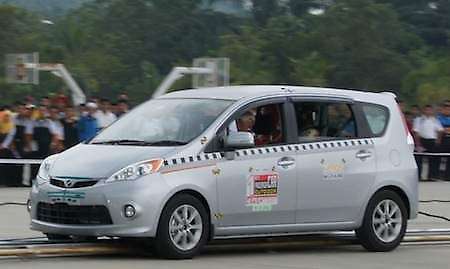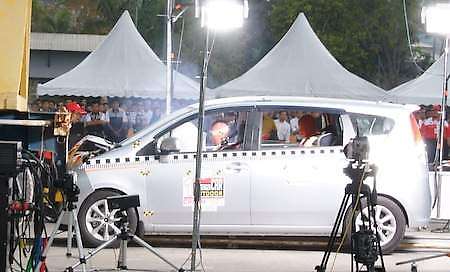
Malaysian Institute of Road Safety Research, also known as MIROS conducted the country’s first passenger car outdoor crash test at the Malaysian Institute of Aviation Technology (MIAT) in Dengkil yesterday. The crash test is the institute’s second following a crash test that involved a motorcycle and a car conducted earlier in January. According to MIROS this test is a prelude to a full-fledged crash test facility that is being set up in Malacca and is expected to be operational by June this year.
Yesterday’s test focused on three aspects including analyzing the safety levels involving a child seated in a safety seat compared to a child wearing just the rear seat belt as well as analyzing the degree and type of casualties sustained by occupants of a vehicle involved in a rear-end collision with a parked or stationary commercial vehicle. It is NOT a crash test for the Perodua Alza, but it just so happens that they used an Alza.
The main focus was to study the effectiveness and level of damage sustained by an energy absorbing underrun protection system developed specifically for commercial vehicles. An underrun is made to absorb impact caused by a rear-end collision and it is compulsory for commercial vehicles. However many commercial vehicles out there don’t even use one and most use unspecified ones.
The guinea pigs for the test? Crash test dummies, a 6-tonne stationary trailer (including load) and a Perodua Alza. The 1.5 EZI Automatic model was used and it was occupied by five crash test dummies including two Hybrid III dummies fully equipped with various sensors, one non-instrumentation Hybrid III dummy, one P3 dummy with nominal instrumentation and a child dummy which simulates a 3-month old child.

A propulsion system featuring a 2.5L Nissan RB engine with pulleys and hydraulic tensioners, various high-speed cameras with up to 1000 frames per second recording capabilities, high-voltage lighting system, a comprehensive Data Acquisition System (DAQ) designed by MIROS as well as various sensors were also used for the test. The crash target was a stationary trailer fitted with an underrun that partially meets the United Nations Economic Commission for Europe (UNECE) Regulation 58 standards.
The plan was to get Alza to crash into the trailer at 35 km/h although the test was eventually carried out at 30 km/h. The crash test was a successful one while the findings are still being analyzed at the moment. Right after the crash it was evident that both the front airbags on the Alza were deployed and the damage on the MPV was limited to the fore front area of the vehicle leaving the engine’s position and vital parts of the interior including the dashboard and pedals intact.
According to a MIROS engineer, initial findings revealed that all passengers except for the 3-month old child would have survived and would only sustain minor injuries. The child would survive if a safety seat was used. This means that the underrun did its job. Although the impact occurred at 30 km/h which is a speed level most of us use while driving in a shopping mall’s parking lot, it was enough to push the 6-tonne trailer forward by at least 2 feet! Imagine that!

MIROS also revealed its plans to make Malaysia a regional hub for crash testing where auto makers can perform various crash tests for vehicles that are specific to the region. The institute also aims to gain international accreditation to serve this purpose. MIROS believes that secondary findings obtained by its foreign counterparts may not be 100% usable for local and regional markets due to the vast difference in geographical, infrastructural, political, and social environments.
The institute also awards the Malaysian Vehicle Assessment Program (MyVAP) certification to vehicles that conform to MIROS’ safety standards and the Alza became the second vehicle to obtain the MyVAP certification after the Proton Exora. Both the Malaysian-made MPVs now carry 4-star MyVAP ratings. MIROS aims to reduce fatalities on the road and setting up a crash test facility is definitely a good step towards reaching that goal however the institute also calls for the public to understand and accept change to become more safety conscious on the road.
It was also revealed that UNECE R58-compliant underruns are expected to become compulsory in Malaysia by October this year, which will make the highways a safer place for us. Most of our low rider passenger cars and even some lower then usual SUVs protect us best against crashes with other vehicles of similiar height. When faced with a high object such as the rear of a trailer, the end result can be very tragic. The car will often slide under the truck, and the full impact will hit the car’s A-pillar, and not the crumple zone built into the front of the vehicle. Underruns will be able to reduce damage from these crashes and ensure the crumple zone takes the hit and not anything else that wasn’t designed for it.
Watch the crash test video below and look after the jump to view an image gallery.
[zenphotopress number=999 album=871]
Looking to sell your car? Sell it with Carro.











AI-generated Summary ✨
Comments generally express skepticism about the low 30km/h crash test speed, questioning its realism and effectiveness in representing actual accident scenarios, where impacts are often higher. Many note the trailer moved during the test, implying flaws or intentional setup for safety demonstration rather than an authentic crash. Some argue the test's primary aim is to showcase underrun protection and safety features, not vehicle crashworthiness, and criticize the lack of higher-speed testing. There’s concern over the test’s validity, with calls for more rigorous and standardized testing similar to EuroNCAP procedures. Questions about the use of the Alza for the test, and whether it truly reflects real-world crash conditions or is mainly marketing, are common. Overall, sentiments range from cautious support to outright disappointment and accusations of gimmickry.